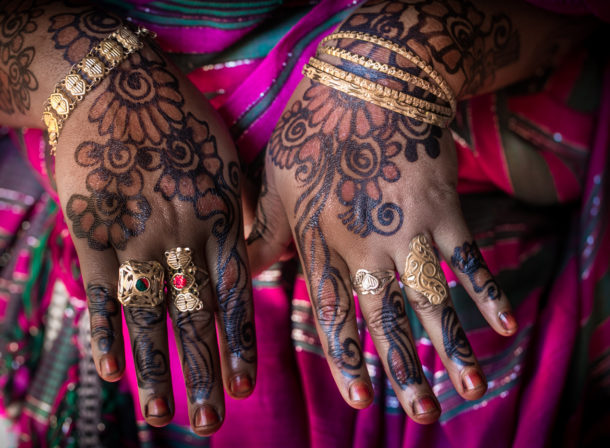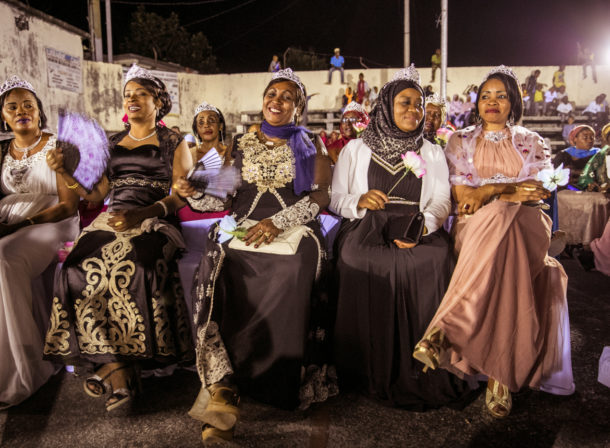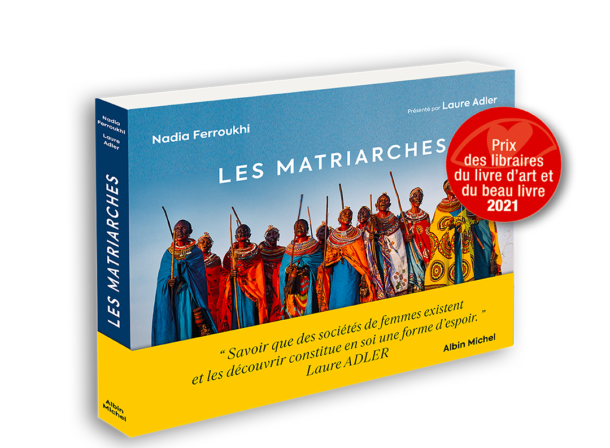Comorian society is a combination of African Bantu traditions and Muslim religion. A newborn child lives with his mother, surrounded by his aunts and grandmother from the maternal line. The manyahuli means that land is passed down mainly from mother to daughter, rarely to the sons. It is interesting to note that the head of the lineage, mothers and eldest uncles, decide on the distribution of wealth according to individual needs.
Polygamy is authorized but not very widespread. Specific to this culture is the fact that even in the lowest social strata, the co-wives never live under the same roof because each one lives in her own house. The man is the one who takes turns to sleep in each woman’s house. The manyahuli land ownership structure and the daho house tradition help women suffer less from the consequences of a divorce, since the man is the one forced to leave while women remain in their homes with the children.
In this rule of matrilocal residence, the husband is the one who moves in with his wife after marriage, and not the other way around. The construction of this marital residence is a concern that starts with the birth of a little girl. The impressive number of houses under construction is a testimony. Sophie Blanchy, ethnologist specializing in the anthropological study of the populations of the Comoros archipelago writes, "these rising walls are like little girls growing up".
In the Comoros, the great marriage, the ndola nku, is an old tradition and is part of the last in a series of rites of passage which gives an honorary rank in society, but costs families years of savings. A great marriage is only celebrated for the first union of a woman, so the virtue of young girls is a major issue and conditions the success of a long-prepared project.
From its original population, Grande Comore has retained two essential and structuring characteristics provided by the African populations: matrilocality and matrilineality. Nevertheless, Comorian society is today won over by outside influences, which somewhat shakes up the traditions and the established order.
As a consequence of divorce, the mother keeps the children and the man leaves the marital home. He goes back to his former house if he has one and eats either at his sister's house, or at one of his wives’ houses if he happens to be polygamous, or in the vala, the shed in which he lived along with other comrades when he was a teenager (it is at this time of their life that young boys leave the family home to gain their independence). Here, the young bride waits for her future husband to enter her house.
Each guest must also contribute either money or labor, which pays for all costs. The paid sums are entered on a register with the name of the donor. These donations help the bride and groom but it is also a debt that they will have to repay by contributing in turn to future great weddings.
One of the many stages of the great marriage is that each of the families offers their child’s spouse the vao, a wardrobe for the wedding, but also for daily life. Everything is presented on trays in the eyes of everyone, because it is crucial to expose one’s wealth.
The vao or gift trays are transported from the home of the bride's family to the home of the groom's family.
The anda designate the ceremonial exchanges organized for all stages of the life cycle, those of the marriage being the most visible and most expensive. This is the ndola nku, the great wedding. The celebration of ndola nku can be the affair of a lifetime, and the celebrations can stretch at length, ranging from about fifteen days at least to several years, in which case it carries on in stages, depending on means. A debt is social and not financial.
The accounting of the money donated for the wedding by the community and family is always in everyone’s sight. A family member announces aloud who paid and how much.
Women sew the jewelry on panels, to be admired by guests. The groom gives these mtawo, or gold and silver jewels, to his wife on the day he joins her at her new home.
The zifafa designates the astonishing journey through the village between the bride and groom’s two houses. Male members, but more often women of the husband's family, in charge of the jewelry sewn by the women, display it on the panels for all to see before being offered to the wife.
At the end of this journey, the bridegroom finally enters the bridal house. As part of a matrilocal organization, he moves in his future wife’s house: this is the heart of marriage. Hwenda dahoni literally translates to "go into the house". The husband is thus considered as a mdjéni, a guest in the matriclan, and this until the moment he gives children to his wife and is then considered a mbaba or father.
Throughout the ceremonies, men and women are mixed, with the usual rules of politeness and respect. On the other hand, male ceremonies and female ones coexist, such as during the ndola nku, the great wedding.
The manyahuli is the house and / or land handed down from women to children. It is transmitted only "through the stomach", that is, in a matrilineal fashion. These goods must be transmitted and cannot be sold, excepted in exceptional cases.
Most of the population is rural and lives from farming or fishing. The economic situation makes daily life difficult. The very supportive Comorian diaspora provides a major contribution to daily life and to exceptional expenses of the village by sending money back home.
In the Comoros, one works to provide for the needs of one's family, the saved money is primarily allocated to family needs: marriage, pilgrimage to Mecca, births, funerals. A large majority of Comorians go into debt, and sometimes for life.
Here, man works the land (manyahuli) of his wife, sister or mother. In a subsistence economy these lands guaranteed agricultural resources for the family group. They still represent an important contribution to today’s family staple; they also have a matrimonial dimension by perpetuating the memory of ancestors and grandmothers.
Despite a matrilineal and matrilocal system, the Comorian man gives little place to women in the political sphere as well as in the street. Conversely, he isn’t allocated much room in the house, and no space of his own: he has to be outside most of the time. Two worlds cohabit, the mila na ntsi, a body of unwritten traditional customs, and the sharia or Islamic law. Issues of inheritance and transmission remain complicated to manage, but most of the time customary law is respected.




















































